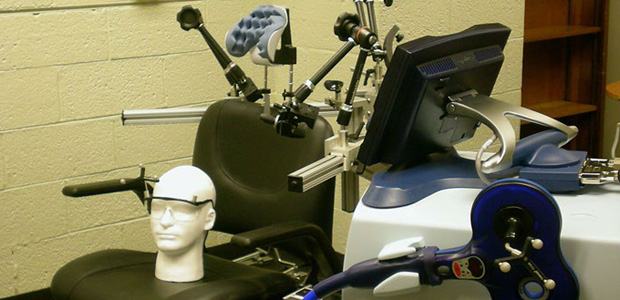
Transcranial magnetic stimulation equipment for our shared cognitive neuroimaging facility.
Current Projects
Rhythm processing deficits in developmental stuttering
Investigators: J. Devin McAuley, Soo-Eun Chang, Laura Dilley, and Juli Wade
Stuttering affects 3 million Americans. Children with chronic stuttering face lifelong struggles, impacting academic achievement and leading to negative psychosocial consequences. Scientists have been intrigued by the fact that stuttering speakers are more fluent when singing, or speaking in synchrony with an external pacing mechanism such as a metronome. These well-substantiated clinical findings suggest that people who stutter may have core deficits in rhythm processing. This project will be the first systematic investigation of the role of rhythm processing deficits in developmental stuttering. The general approach will combine behavioral and neuroimaging studies in children with studies in songbirds, which under controlled conditions can be induced to stutter.
Research supported by the GRAMMY Foundation.

Mechanisms of time and rhythm perception
On the time scale of human communication, there is empirical support for at least two distinct types of timing mechanisms: an interval-based (‘stopwatch’) mechanism that records, stores and compares event durations and a beat-based (‘entrainment’) mechanism that assesses the relative timing of events with respect to an internally-generated periodicity. A topic of research on timing that has received relatively little research attention is the issue of individual differences. This project considers the possibility that individuals engage in beat-based and interval-based timing, but do so to different degrees. The general aim of the NSF funded project is to identify and characterize factors mediating engagement of beat-based and interval-based timing mechanisms. For this project three inter-related lines of research combine a novel sequence-timing paradigm that demonstrates robust individual differences, with a mathematical model that indexes the degree to which performance reflects beat-based judgments. Critical to the sequence-timing paradigm are stimulus sequences that yield opposite perceptions about sequence rate (‘speeding up’ versus ‘slowing down’) depending on whether individuals engage in beat-based or interval-based timing, respectively. The first line examines stimulus characteristics mediating beat-based timing. The second line assesses flexibility in timing mode, focusing on attention and task factors. The third line addresses developmental and training factors. A key contribution of the modeling work is that it integrates two contrasting theories of timing within a single framework. Using this framework to clarify the degree to which individuals engage in beat-based timing improves current limited understanding of individual differences in timing behavior and helps better characterize temporal processing deficits linked to neurological disorders.
Return to topThe role of narrative listening in music perception
Music and language are both modes of human communication that convey meaning. Although there are many studies of how language acquires meaning, little is known about how music becomes meaningful. One hypothesis is that music acquires meaning in part because listeners impose narrative significance to musical events, translating abstract musical sequences into a story line as the notes unfold (a process known as narrative listening). A series of parallel experiments will be conducted that vary both the structural features of musical excerpts and the cultural background of the listener in order to disentangle questions about the role of nature and experience in the formation of musical meaning. Learning more about the mechanisms that underpin musical meaning fundamentally adds to our understanding of human communication and artistic expression, with the broader potential to lead to improved intercultural exchange. The work will also contribute new methodologies to probe the musical experiences of lay listeners across cultures, who often lack the musical vocabulary to describe their perceptions. By bridging science and the humanities, the project will provide STEM-based research training to students in the humanities and, in turn, expose students in the sciences to questions in the humanities that would benefit from development of novel scientific methodologies. The project’s reach will be expanded by the development and dissemination of a new app for collecting crowd-sourced data via cell phone. Embedded GPS technology will allow the researchers to map patterns and variations in narrative listening across geography and cultures.
This project takes a theory-driven and cross-cultural approach to investigate the core factors that shape narrative listening to music. The investigators will obtain a normative set of cross-cultural data on narrative listening for a large sample of Western and Chinese musical excerpts from both American listeners with little exposure to Chinese music and from Chinese listeners will little exposure to Western music. If narrative listening arises from a fundamental tendency to make abstract stimuli concrete, then listeners will tend to ascribe agency to points in the music that violate their expectations in order to make sense of what they hear. If narrative listening arises from enculturation, people should be more likely to perceive narratives in music from their own culture than from a different culture. Within a culture, people should be more likely to perceive narratives for high topical-association music than for low topical-association music. Lastly, the investigators will examine the relationship between narrative listening and other well-studied aspects of music perception, providing novel insights about established phenomena and opening up new avenues of investigation.
Return to topThe effects of melodic and temporal accents on tempo determination
Research on tempo has concentrated on the concepts of preferred tempo (i.e., spontaneous tapping rate), tempo memory (tempo memory/imagery for familiar songs, or group memory for tempo), and tempo identification/discrimination (the ability to identify or discriminate different tempos). However, there has been very little research on tempo determination, or the process of determining an appropriate tempo for an unfamiliar musical excerpt. This study investigates what melodic characteristics provide contextual cues for appropriate tempo in an unfamiliar melody, including melodic accents such as contour skips and leaps, range, and overall interval size. The salience of these accents will be discussed, and eventually the goal of the research is to provide a model for factors that are used in a tempo determination task.
Return to topThe role of rhythm and speech recognition in noise
Return to topFacilities
Offsite MRI Scanner
MRI Scanner
A core facility available for dedicated research use is a state-of-the-art GE 3T Signa HDx MRI scanner (GE Healthcare, Waukesha, WI) equipped with the latest hardware and software available to this platform. A wide range of human and animal imaging studies are carried out using this equipment. This scanner is supported by and located at the Department of Radiology.Shared Cognitive Neuroscience Facility
Support the development of this facility by donating here.
TMS
Image-guided (neuronavigated) Magstim/Brainsight Transcranial Magnetic Stimulation (TMS) is housed in our shared cognitive neuroimaging facility. This equipment has the capability for both single-pulse and repetitive TMS stimulation. TMS is a technology that is increasingly used in human cognitive neuroscience research to produce temporary disruptions to neural activity or to stimulate the cortex in targeted brain regions.Eye blink equipment
The facility also includes equipment for carrying out eyeblink experiments. This equipment consists of a headphone apparatus that delivers tones and puffs of air, and a computer to measure eyeblink responses from facial sensors using electromyography.TAP Lab
